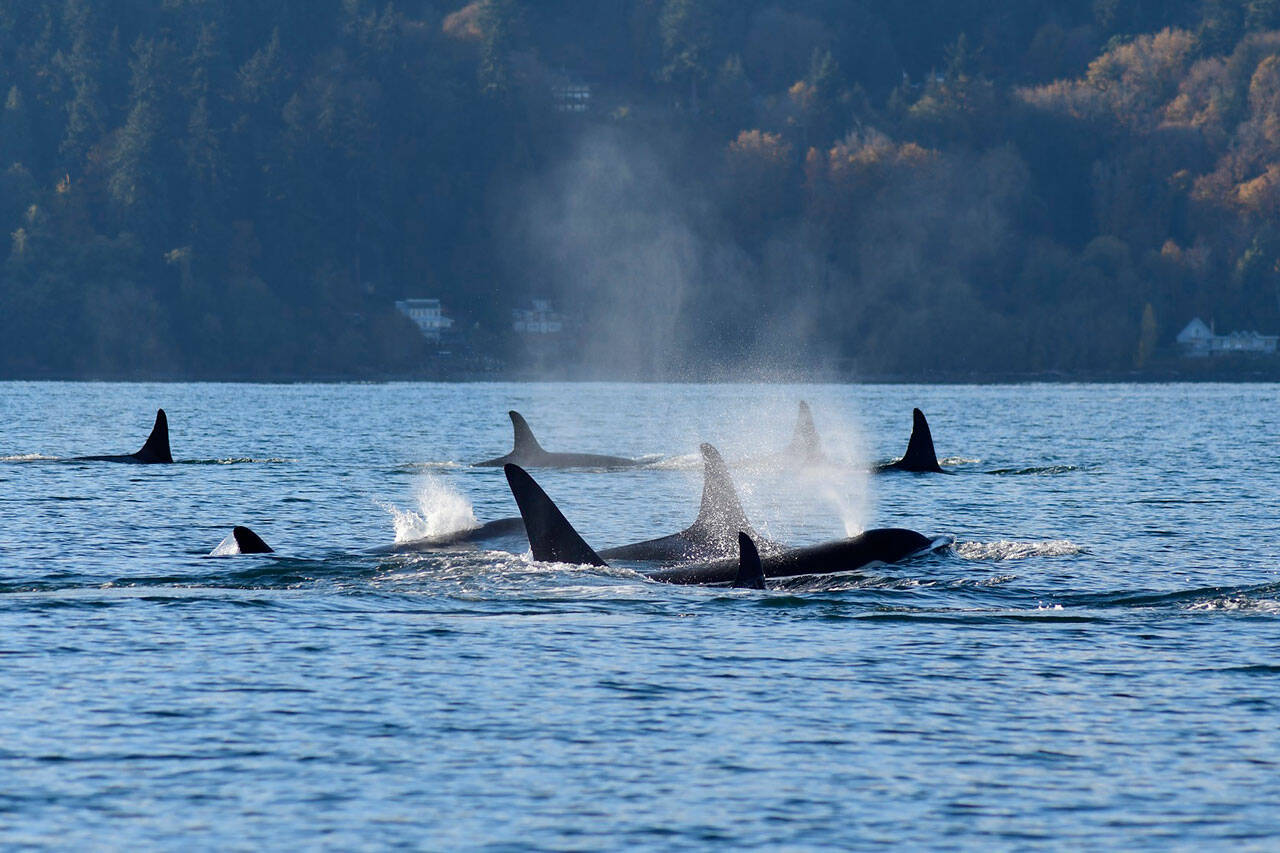The waters of Puget Sound in the vicinity of West Seattle and Vashon were graced by a superpod of Southern Resident killer whales from Nov. 7 to 10 — an occasion for both reverence and concern to those celebrating their return.
This summer, the Washington Department of Fish and Wildlife (WDFW) designated 12 critically endangered SSRKW as vulnerable and at a substantially increased risk of premature death because they are in alarmingly poor body condition.
The malnourished orcas are pregnant Moonlight (L83) and her adolescent son Midnight (L110); female calf Tofino (J56); matriarch Ino (L54); adult female Alki (J36); adult female Calypso (L94); adult female Ballena (L90) — lone survivor of her matriline; adult male Blackberry (J27); adolescent male Moby (J44); juvenile male Tílem Ínges (J49); adolescent male Finn (L116); and adolescent male Keta (L117).
Some SRKW look disturbingly thin; some have “peanut head,” described as fat loss around an orca’s head and behind the blowhole. Moreover, youngsters Kiki (J53) and Lazuli (L123), both seven years old, exhibit stunted growth, and Kiki is in below-average body condition.
Matriarch Racer (L72) merits vulnerable status because she is in late-stage pregnancy.
The pregnancy failure rate among the SRKW is nearly 70%. Research shows that late-stage pregnancy requires as much as 25% more food in the final month of gestation. Boats and other watercraft, such as kayaks, within 400 yards of SRKW interrupt foraging, often causing females to cease feeding.
Because female orcas share prey with their offspring, pregnant and nursing SRKW mothers with young calves are highly sensitive to disruption by vessel noise and presence, which can impede crucial prey capture and sharing.
Researchers from Sealife Response, Rehabilitation, and Research (SR3) used measurements from drone photographs obtained between September 2021 and April 2022 to determine body conditions and identify pregnancies among the SRKW.
Based on SR3’s assessments, WDFW issued an emergency order on June 30, requiring commercial whale-watching boats – and urging all boaters – to maintain a distance of at least one-half nautical mile from endangered SRKW.
In addition, mothers with calves receive extra protection via WAC 220-460-110, which prohibits motorized commercial whale-watching vessels from approaching within a one-half nautical mile of any SRKW group that contains a calf less than one-year-old.
From Nov. 7 to 10, all of these fragile orcas and more were in the vicinity of West Seattle and Vashon, hunting salmon and socializing in a Southern Resident superpod. All 73 members of J, K, and L Pods were likely present: 25 in J Pod, 16 in K Pod, and 32 in L Pod.
The population of 73 is the lowest SRKW population number in 38 years. Diminished prey availability is a major factor in the decline of these orcas. This fall, Chum, Coho and Blackmouth (immature Chinook) salmon are more abundant throughout the north and central Puget Sound areas where the SRKW foraged.
During this four-day period, Mark and Maya Sears were the only NOAA-permitted researchers on the water snapping identification photos and collecting fecal, prey, and other samples.
They confirmed the presence of all SRKW matrilines (family groups) and babies born in 2022 — J59 and K45, both females. J59’s mother is Hy’Shqa (J37), age 21, and K45’s mother is Spock (K20), age 36.
Mark Sears first spotted Hy’Shqa as a baby in Vashon waters in 2001. He also discovered Spock’s first calf, Comet (K38), in Colvos Pass in December 2004. Beloved Blackberry (J27), age 31, appeared skinny when he breached, but he is energetic.
On Nov. 9 and 10, part of the superpod ventured into waters off Vashon’s northeast side. Several orcas traveled as far south as Tramp Harbor on Nov. 9, where Odin Lonning and I observed them. At least 30 SRKW, some breaching, slowed the ferries and graced the triangle run morning commute on Nov. 10.
These SRKW encounters are extraordinary because L Pod has not visited Vashon since January 2020, and superpods are now infrequent. A superpod in the central Sound is quite rare. The last well-documented superpod occurred in September 2018, near Victoria, BC.
We celebrate the annual return of our imperiled SRKW to Vashon, and encourage islanders and visitors to embrace personal behavior that promotes recovery of this culturally and spiritually significant orca population.
Actively reducing our carbon footprint benefits orcas and their food source, salmon. We tread lightly when we refrain from chasing critically endangered SRKW – in fossil fuel emitting cars, boats and ferries — all over the Salish Sea, and by watching orcas at a shore-based location closest to where we reside.
Reporting whale sightings to Orca Annie Stateler at 206-463-9041 and vashonorca@aol.com supports the non-invasive work of researchers Mark and Maya Sears.
Orca Annie Stateler is an Indigenous marine naturalist, educator, researcher, stranding responder, and founder of the Vashon Hydrophone Project.



